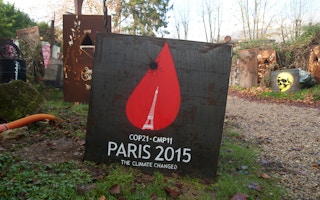US President Donald Trump’s withdrawal from the Paris Climate Accord was greeted with consternation in the rest of the world. Both the United Nations and former President Barack Obama described the decision as a major setback.
I find myself on the same side with the US leader on the Paris Accord, particularly on his call for a new climate deal although my reasons are very different to his. Trump argued that the treaty would affect US jobs and businesses. He also claimed that even if the Paris agreement was implemented in full, its impact on global temperatures would be negligible.
All these reasons have been fact-checked and there are grounds to question his analysis. But his call for a new climate deal or a renegotiation of the agreement would be an opportunity to make the agreement work better from an international law perspective.
The Paris Agreement is weak, lacks an enforcement mechanism and does not clarify liability for climate change. This puts developing countries that have contributed less to global warming at a disadvantage due to the fact that countries that have contributed the most towards global warming are not legally liable or compelled to assist developing nations to adapt to climate change.
“
What drove the drafters to imagine that the climate treaty would receive the attention it deserves with no enforcement mechanisms?
The anticipation was that through the agreement, developed nations would fund the adaptation strategies of developing nations. But weaknesses in it mean that the flow of funds isn’t guaranteed. It’s estimated that the cost of meeting the demands of mitigation could reach well over $500 billion a year for developing countries.
The agreement’s objective is to strengthen the global response to the threat of climate change in the context of sustainable development. The pact requires countries to set goals to reduce carbon emissions. To monitor this, signatories are to meet every five years to report on their respective emissions levels and reductions.
Central to this agreement is the hope that, of their own accord, governments will prioritise the fight against climate change. The programme and targets that each country seeks to meet are nationally determined and implemented, taking into account their respective ability and circumstances.
What this effectively means is that each party has a wide discretion. They can choose what measures they’ll implement to combat climate change. Governments can also determine what financial sacrifices they’ll make. So, if a government chooses to fund its health and education sector rather than reducing greenhouse gas emissions it is free to do so.
This means that there’s no institution or mechanism to determine if the measures taken by countries are sufficient. This could lead to a situation in which the world’s top greenhouse gas emitters simply point fingers at one another and while making the least effort to uphold the agreement.
A deal that doesn’t have proper accountability measures built into it and isn’t enforceable can’t be a good one – most particularly for developing countries.
Non-adversarial and non-punitive?
The job of overseeing the implementation of the Paris accord is vested in a committee. The agreement proposes that the committee be expert-based, facilitative in nature and functions in a way that’s transparent, non-adversarial and non-punitive.
The use of the words “non-adversarial’ and “non-punitive” point to the voluntary nature of the pact. I believe this renders it ineffective. Even United Nations agreements backed by the threat of sanctions often don’t work. For instance, though the use of chemical weapons is banned, the United Nations Security Council failed to investigate fully, or punish, violations in Syria this year. What drove the drafters to imagine that the climate treaty would receive the attention it deserves with no enforcement mechanisms?
In fact, one would have expected the Paris agreement to rectify the challenges that have plagued the UN Framework Convention on Climate Change. Under this framework, countries have gathered each year at the Conference of Parties (COP) to negotiate agreements on how to combat climate change. In 1997, the conference adopted the Kyoto Protocol.
This was commendable in 1997 but research indicates that over the years countries actually failed to meet their Kyoto commitments. None faced any consequences and a perfect example would be Canada whose withdrawal from the Treaty extinguished any consequences for non-compliance. In addition, the US failed to ratify the protocol yet it was the largest emitter at the time of signing.
The seeds of the Paris agreement were sown in the Kyoto protocol. The major difference between the two is that the Kyoto protocol has targets for leading economies. This made it very unpopular which led to most states at the Paris conference demanding a more flexible approach.
Accountability
The reality is not every country will be able to combat the adverse effects of climate change effectively while still guaranteeing the well-being of its citizens.
The solution offered by the Paris Accord is to get developed countries to commit funds that will be facilitated through a UN framework to the benefit of developing countries. This essentially translates into vested economies like the China and the US subsidising the efforts of highly vulnerable regions such as Sub-Saharan Africa and South East Asia.
There is fairness in this arrangement since these regions don’t have a history of large emissions.
The World Resources Institute shows that China is the largest polluter followed by the US, EU, India, Russia, Indonesia, Brazil, Japan, Canada and Mexico. In line with the restorative principle, the Paris Accord came close to getting countries that warm up the globe to foot the bill for efforts to restore and preserve natural resources.
Unfortunately, coming close is all that it did.
In his official statement outlining the reasons for the US withdrawal, Trump repeatedly mentions his willingness to re-enter negotiations on a new deal. This call is not necessarily a bad thing. A new round on how we save planet earth would give leaders the opportunity to craft a binding and enforceable agreement.
![]() Hopefully it would take into account actual environmental damage, loss and liability. And developing countries could demand accountability for greenhouse gas emissions.
Hopefully it would take into account actual environmental damage, loss and liability. And developing countries could demand accountability for greenhouse gas emissions.
Ilyayambwa Mwanawina is Senior Law Lecturer at North-West University. This article was originally published on The Conversation.









